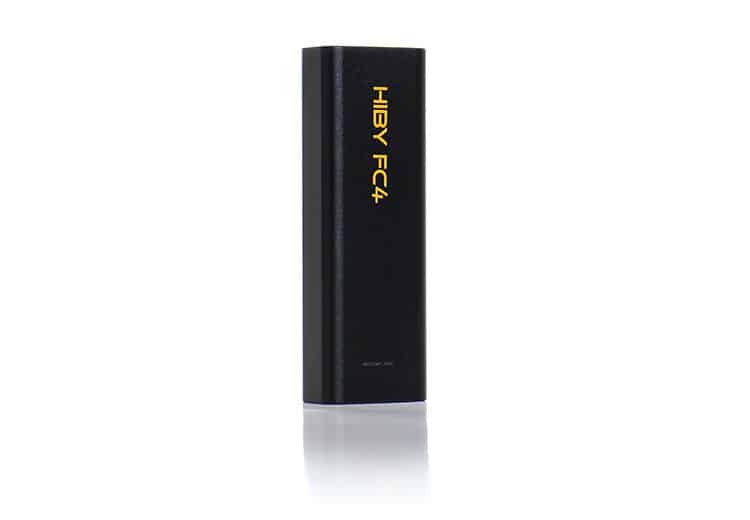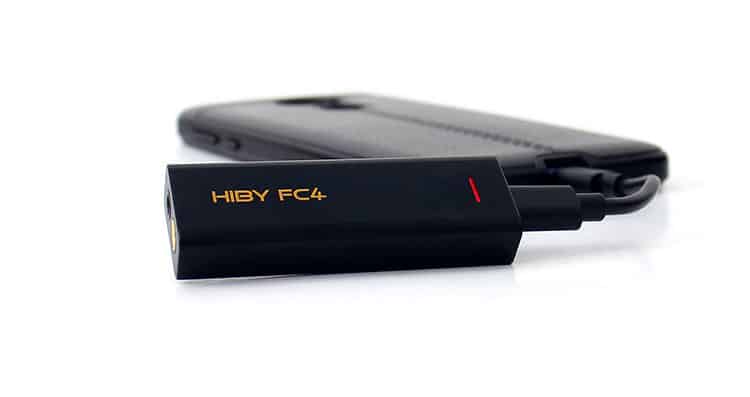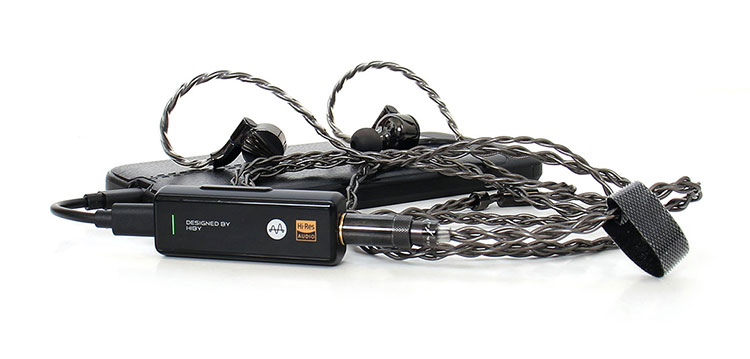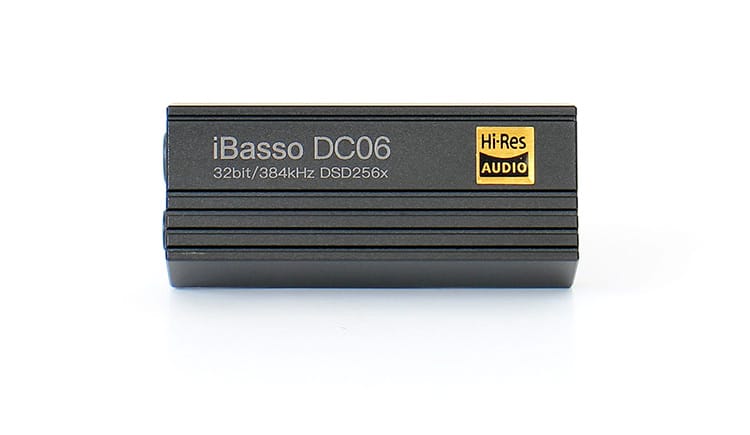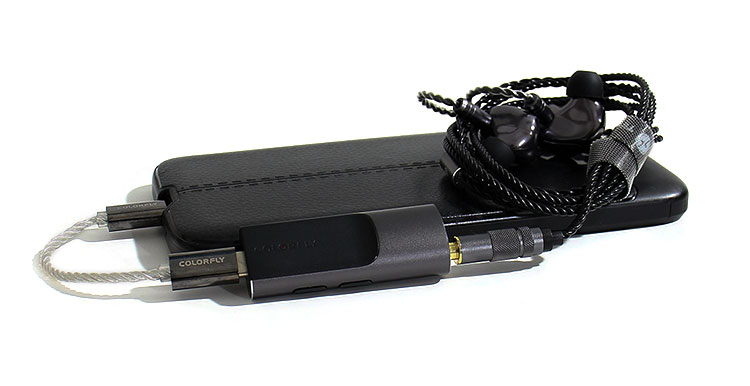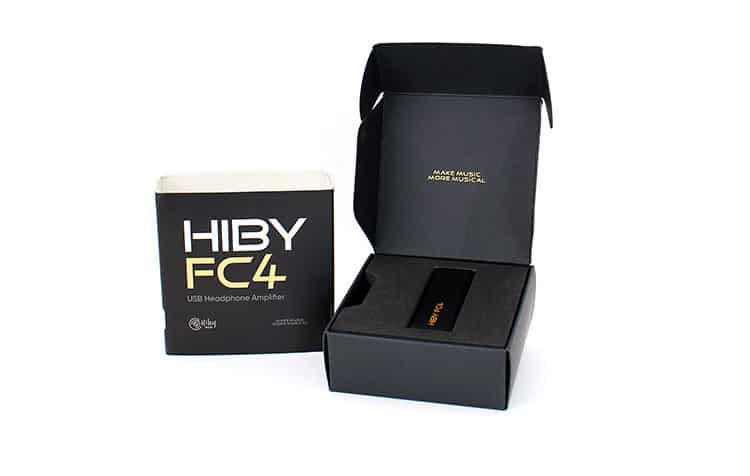Synergy
Power
The HiBy FC4 has a very good power output to power usage ratio. While using full-sized headphones volume has to increase to reach the same acceptable levels as with IEMs so of course power consumption will rise considerably. The FC4 body does get slightly warm at times, but the keyword is slight.
If you maintain a moderate volume power consumption remains low. I was able to listen to four full-length songs and on the fifth song, the battery percentage dropped 1%. The battery size on the particular mobile device used is 5000mah.
This test was done with high-current planar headphones such as Dekoni Blues and HIFIMAN HE400se so you could most definitely squeeze more time from the source’s battery if you use efficient IEMs instead.
Pairing
The drivability capability of the HiBy FC4 seems rather high since it can push high current and somewhat demanding headphones like the HIFIMAN HE400SE or the Dekoni Blue T50 MK3 variant. Both these headphones produced sound with a surprising amount of bass when pushed by the FC4.
With 340mW of power per side, the FC4 seems to have an ample amount of power for almost any situation. With IEMs you could stick to using the 3.5mm side but you’ll lose a whopping 3 decibels of SNR though that might not be a big deal for some.
Pairing the FC4 with some hybrids like the FiiO FH9 or a dynamic driver combo like the Unique Melody 3DT did not present any drivability issues whatsoever.
Tonality-wise, combinations should not be of much concern since the MSEB feature can take care of sibilance and excess warmth. It can correct most dislikes in coloration many could possibly run into.
Select Comparisons
HiBy FC5
$159.99
Technical
I consider the FC5 to be the FC4’s big brother since it has a more mature or let’s say more refined DAC SoC selection plus an additional 2 chips upfront that form part of a separate amplifier section circuitry.
The FC5 uses a pair of ES9281pro SOCs plus a pair of ES9603Q headphone amps. Both chips were made by ESS to pair up perfectly. The circuitry maintains a low power consumption concept which sort of explains away the conservative only listed power output of 125mW available from its single 4.4mm connection.
What I’m truly scratching my head on is the fact that the FC4 can handle higher DSD sampling rates plus a higher power output rating and on top of that it offers dual headphone output jacks and higher power output. I would not use both jacks simultaneously but it sure helps for connectivity versatility.
Design
The HiBy FC5 sports a smaller size in general over the FC4 by a considerable amount. However, the small size was probably accomplished by ditching the 3.5mm connection and by only placing a 4.4mm connection onboard. The USB-C connection for the input side is commonly carried over in the design.
The FC5 has tempered glass on one side and a softly displayed HiBy FC5 ID on the flip side. The FC5 also has a Hi-Res and an MQA logo but not the FC4 which keeps things simple far as labeling. Both dongles seem to have an almost identical anodized matte black finish overall.
Both dongles have similar format indicator LED strips but the FC5 has it below the tempered glass while the FC4 has it under a cutout that’s prone to picking up lint and dirt. Overall, it seems more attention to design detail was placed on the FC5.
Performance
The HiBy FC5 has the slightly silkier sounding midrange section and there’s a slightly higher level of detail retrieval as well, which is probably attributed to the higher tier SOCs. The FC5 seems the more neutral of the two but the bass response, in general, seems meatier on the FC4.
Power output drops considerably and comparatively to the FC4 so if you use IEMs the better choice might be the FC4 because of the slightly and subtly more refined sound signature. However, if you plan on using full-sized headphones at times, the best choice would then be the FC4 due to its higher power output capability.
The overall sound signature to me of the FC5 seems more neutral, especially in the bass response. The treble however seems a touch hotter but it does seem to reach higher into the upper frequencies and does not dip as early which I suspect the FC4 does somewhat since it seems more relaxed in the highs.
iBasso DC06
$119.00
Technical
The iBasso DC06 is another dongle DAC that competes well in this price bracket and even against some higher-priced models. This fact is mostly attributed to its small size and rather high-power output capability which practically equals the FC4 in that aspect.
The DC06 is my favorite dongle within the iBasso lineup up to date and possibly one of my favorites within its price category. It shares a dual SOC design that uses two ES9219C accompanied by an NDK Femtosecond oscillator.
With a similar power output rating, the DC06 can dish out 335mw which puts it in second place and bested only by the FC4 but only by a minuscule and an insignificant 0.005mw. Both these dongles actually perform very similarly. Even their SNR is rated identical on both dongles and listed at 123db.
Design
The iBasso has a somewhat rougher cut shell design with some pointy edges but it seems to be the most robust build of all the models within this comparison section and is also the smallest in size.
The shell has a somewhat old-school car amplifier vibe with cooling fins and all, but not that they’re really needed because the DC05 barely runs warm.
Connectivity is identical on both dongles. There’s a 3.5mm plus a 4.4mm connection on one end. The other end is equipped with a USB-C input identical to the FC4.
However, the DC06 does not have an onboard volume control like the FC4 and the rest of the dongles in this comparison. You could download iBasso’s UAC app which gives the user a 64-step volume control but it’s a digital volume and not an onboard one. It does have a finer amount of control and more steps than the others.
Performance
These dongle DACs blur the line of performance because it’s really hard to tell which one is which in a blind listening test. Both these dongles use dual ESS chips. They both sound slightly warm with good bass extension but are neutral in general character.
Perhaps there’s an ounce more bass bloom coming off the FC4 but it seems to be tuned for better low-end extension while the DC06 seems to be tuned with vocal clarity and high-frequency response clarity in mind.
Colorfly CDA M1
$89.99
Technical
With an identical connectivity configuration, the Colorfly CDA M1 has most of its differences internally with a single ESS Deep custom A-Alpha DAC section and an opamp implementation consisting of a pair of RT6803 chips that provide the final output power.
As far as digital formats are concerned, the CDA M1 can reach a higher DSD512 level and 32-bit 768k PCM but it cannot do MQA so you’re limited to those, albeit more important digital formats.
Design
The Colorfly CDA M1 is certainly the lightest dongle in this 4-model comparison. The general CDA M1 design does make it the oddball of the bunch. The shell’s general shape is a tapered oval with a very small and cleverly placed format indicator LED.
The onboard rocker-type volume control is not a hardware-level volume control and it ties itself to the source volume. I do prefer the hardware level volume control of the FC4 most certainly plus keep in mind that the CDA M1 has no gain control to counteract.
One oddball aspect of the CDA M1 is that you get no literature inside the box but to its merit, the CDA M1 product presentation is the best of the bunch. However, the accessories list is somewhat common fare with the inclusion of dual-sided male USB-C connectors and a gender changer over from USB-C to full-size USB A type.
Performance
The Colorfly CDA M1 seems to be a midrange forward and foremost dongle although the general tonality seems balanced and neutral as a whole. It does have the highest SNR rating of the bunch at 130dB on the balanced side but it drops down to 120dB on the 3.5mm tap.
The two extremities seem controlled in a way that the high frequencies stay below an irksome threshold while the bass remains neutral with a lack of bloom or elevation. You could even say the bass portion is on the shy side.
The CDA M1 also takes a hit when it comes to raw power output but there is a sense of high gain with the CDA M1 and since there is no physical or software gain control you have to moderate volume more cautiously and unfortunately it doesn’t have the fine control the other dongles have.
One area to accredit the CDA M1 on is the dynamic response which shows off a snappy character that speeds along and which highlights that rather high signal-to-noise ratio specification.
Our Verdict
It seems HiBy outdid all their other dongle DACs because I don’t consider the FC4 to be a downgrade from specs alone and from the FC5 because it outdoes the FC5 in some areas. The FC5 might be a more tonally refined dongle but the differences are minuscule and the extra power output of the FC4 makes up for it.
The volume control has an excellent implementation which helps the user obtain a finer amount of control. Add to that an app with lots of cool features next to a decent music player and it all adds up, especially if you throw in the dual headphone connectivity.
The only aspect that perhaps did not go in the right direction is the shell size did increase some over the FC5 but so did the power output by a considerable margin. So, you get more for less basically. I like that.
HiBy FC4 Technical Specifications
- Dimensions 3×22.1×11.9mm
- Weight 7 Grams
- DAC ES9218 x2
- Buttons Volume up / down
- Supported formats PCM 32 bit/ 768kHz, DSD256 Native, MQA 8x
- USB Port Type C
- Headphone Out 5mm TRS and CTIA spec TRRS
- Balanced Output 4mm Balanced
- Output Level 9Vrms / 3.3Vrms @32Ω
- Output Power 110mW / 340mW @32Ω
- THD+N 0008% / 0.0006% @32Ω
- Noise 7Vrms / 2.2Vrms @32Ω
- Dynamic Range 120 dB / 123 dB @32Ω
- Crosstalk rejection 72 dB / 98 dB @32Ω
- Frequency Response 20 – 90 kHz

